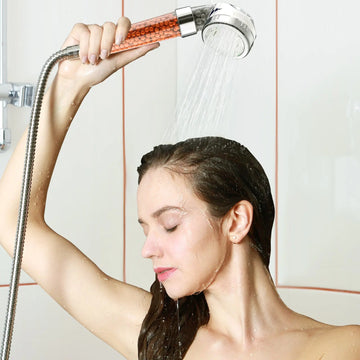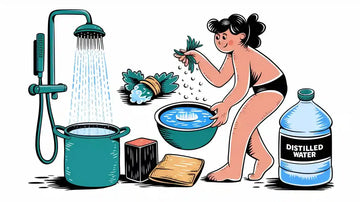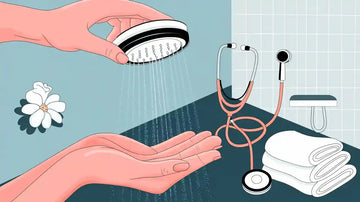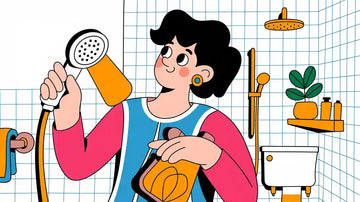You want clean water in your shower, but you may not want a filter shower head. Many people worry about chlorine, heavy metals, and other things that can make water bad. Studies show too much chlorine in shower water can dry your skin and hair. Warm water opens your pores. This makes it easier for chlorine and other things to get into your body. These things can cause irritation and even hurt your health. If you see dry skin, weak hair, or strange smells, your water may need a filter. Think about your skin, your money, and how easy it is to set up a solution before picking the best way to get healthy skin and better water.
Key Takeaways
You can clean shower water without a filter shower head. You can use whole house filtration, water softeners, inline filters, portable purifiers, or DIY ways. Whole house filtration cleans all water in your home. It removes chlorine, heavy metals, and bacteria. But it costs more and needs a professional to install. Water softeners take out hard minerals. These minerals can make your skin and hair dry. But softeners do not remove chlorine. Using softeners with filters works best. Inline and portable filters are simple to put in. They take out chlorine and metals. This helps your skin and hair feel better. But you must change the filters often. Test your water first to see what is in it. Then choose a way that fits your needs and budget. This will give you cleaner and healthier shower water.
Filter Shower Head Alternatives
You have lots of ways to get clean shower water without a filter shower head. Each choice helps with different problems in the water. These options can help with chlorine, heavy metals, hard water, and other issues. Let’s see what these choices are and how they work.
Whole House Filtration
Whole house filtration systems clean all the water in your home. You get clean water for showers, drinking, cooking, and laundry. These systems use special filters like activated carbon, KDF, reverse osmosis, and sediment filters. They take out chlorine, heavy metals, bacteria, dirt, and dissolved solids. Your pipes, appliances, and skin stay safe from bad stuff.
Tip: Whole house filtration is the best way to treat all your water. You get better water everywhere, not just in the shower.
Here’s a table that shows the differences between whole house filtration and filter shower heads:
Feature/Aspect |
Filtered Shower Heads |
Whole-House Water Filtration Systems |
|---|---|---|
Scope of Filtration |
Only filters shower water |
Filters all water entering the home (shower, drinking, cooking, laundry) |
Chlorine, heavy metals (lead, mercury), VOCs, sediments |
Chlorine, heavy metals, bacteria, sediments, dissolved solids, scale formation |
|
Filter Media Used |
KDF 55, activated carbon, calcium sulfite |
Activated carbon, KDF, reverse osmosis membranes, sediment filters, water softeners (optional) |
Effectiveness |
Effective for shower water contaminants only |
More comprehensive and thorough purification across all water uses |
Installation & Maintenance |
Easy to install, low cost, requires frequent filter replacement (3-6 months) |
Higher installation and maintenance cost, professional installation needed, longer filter replacement cycles |
Additional Benefits |
Improves skin and hair health, water softness, smell |
Protects pipes and appliances, reduces scale, improves overall household water quality and health |
Limitations |
Limited to shower water, not comprehensive for whole-house needs |
Higher upfront cost, complex installation, may be excessive if only shower water quality is a concern |
Whole house filtration is a strong way to get rid of chlorine and other bad things. You get the best shower filter for your whole house.
Water Softeners
Water softeners remove hard water minerals like calcium and magnesium. You can pick salt-based, salt-free, dual-tank, magnetic, or reverse osmosis systems. Salt-based softeners swap hard minerals for sodium ions. Salt-free softeners make minerals harmless so they don’t make scale. Magnetic softeners change minerals so they don’t stick together. Reverse osmosis takes out minerals and other bad stuff.
How It Works |
Impact on Shower Water Quality and Benefits |
|
|---|---|---|
Salt-based |
Uses sodium ions to exchange with calcium and magnesium ions, removing hard minerals. |
Soft water protects skin and hair, prevents limescale, and is gentle on plumbing and fixtures. |
Showerhead water softeners |
Installed directly on showerhead; cartridge filter removes mineral deposits before water exits. |
Protects hair and skin from hard water effects, prevents hard water spots on tiles and tubs, easy installation. |
Salt-free |
Uses template-assisted crystallization (TAC) to neutralize minerals without salt. |
Prevents scale buildup without adding sodium; gentle on skin and plumbing. |
Magnetic |
Uses magnetic fields to alter mineral ions so they don't bond and form scale. |
Reduces scale formation temporarily; minerals remain but do not deposit on surfaces. |
Reverse osmosis |
Filters water through semipermeable membranes removing minerals and contaminants. |
Provides very soft, clean water ideal for drinking and bathing; removes impurities beyond hardness minerals. |
Water softeners make shower water nicer for your skin and hair. You stop dryness, itching, and limescale. Soft water makes soap foam better and leaves less residue. Your bathroom and pipes stay cleaner.
- Showerhead water softeners are cheap and simple to put in.
You stop limescale and stains.
You get softer skin and hair.
You use less soap and shampoo.
Some softeners are easy to install, but some need a pro.
You need to change cartridges or refresh the resin sometimes.
Many people say their skin feels better and their bathroom stays cleaner.
Water softeners work better than regular shower filters for hard water. Shower filters remove chemicals, but softeners remove calcium and magnesium. You get softer hair, less frizz, and a healthier scalp.
Feature |
Water Softeners |
Shower Filters |
|---|---|---|
Primary Function |
Remove hard water minerals (calcium, magnesium) via ion exchange |
Remove chlorine, heavy metals, and chemical contaminants |
Effectiveness on Hard Minerals |
Highly effective, softens water, reduces scale buildup |
Not effective at removing hard minerals |
Coverage |
Whole-house solution |
Shower or tap only |
Benefits |
Softer hair and skin, less plumbing buildup, better appliance longevity |
Reduces chlorine-related irritation, easy installation |
Installation & Maintenance |
Higher cost, professional installation required |
Lower cost, DIY installation, low maintenance |
Impact on Hair & Skin |
Smoother, softer hair; reduced frizz; healthier scalp |
Reduces chlorine irritation but no mineral removal |
Inline Shower Filters
Inline shower filters connect right to your shower pipe. You get filtered water just for your shower. These filters use KDF, activated carbon, calcium sulfite, and sometimes vitamin C. They take out chlorine, chloramines, heavy metals, VOCs, bacteria, smells, and waste. Multi-stage filters use more than one type to catch more bad stuff.
Contaminants Removed |
Filter Types |
Average Lifespan |
|---|---|---|
Chlorine (up to 99.99%) |
KDF, Activated Carbon, Calcium Sulfite, Vitamin C |
KDF: 6-12 months (15,000-20,000 gallons) Activated Carbon: 3-6 months (8,000-12,000 gallons) Vitamin C: 1-3 months Multi-Stage: 6-9 months |
Chloramines |
Some multi-stage filters combining KDF and Calcium Sulfite |
|
Heavy Metals |
KDF, multi-stage filters |
|
VOCs (Volatile Organic Compounds) |
Activated Carbon, multi-stage filters |
|
Trihalomethanes (THMs) |
Some multi-stage filters |
|
Bacteria |
Certain filters with KDF media |
|
Odors |
Activated Carbon, KDF |
|
Organic Waste |
Activated Carbon |
|
Common Carcinogens (e.g., carbon tetrachloride, chloroform, benzene) |
Multi-stage filters |

You should change your inline shower filter every few months. This depends on how much water you use and how dirty it is. If water pressure drops or smells change, it’s time for a new filter. Inline filters are easy to put in and take care of. They remove chlorine and other bad things for healthier skin and hair.
Portable Purifiers
Portable purifiers, also called shower filters, are easy to move. You can use them in rentals or when you travel. These filters focus on taking out chlorine, chloramine, and byproducts like trihalomethanes. You lower your contact with chemicals that can turn into vapor in hot water and get into your body.
Portable purifiers use activated carbon, KDF, and vitamin C.
Activated carbon is best for chlorine but not as good for chloramine.
KDF removes chlorine, chloramine, heavy metals, fungi, and bacteria.
Vitamin C filters work on chlorine and chloramine.
Portable purifiers do not make hard water soft.
You may see better skin and hair after using a portable purifier.
Portable purifiers clean water but keep good water pressure. They are simple for removing chlorine and other bad things, but they do not clean all the water in your house.
DIY and Natural Methods
You can try DIY and natural ways to remove chlorine at home. People use things like zeolite, tourmaline, maifan stone, calcium sulphite, and FIR ceramic balls. Calcium sulphite and KDF-55 are proven to remove chlorine and some heavy metals. Zeolite helps with some heavy metals and ammonia. Tourmaline and maifan stone may add minerals but do not really soften water.
KDF-55 uses copper and zinc to turn chlorine into safe chloride.
Calcium sulphite reacts with chlorine to make safe salts.
Activated carbon catches chemicals and smells.
Mineral balls can make water feel better but do not remove hard minerals.
Multi-stage filters mix KDF-55, calcium sulphite, activated carbon, and mineral balls for better cleaning.
DIY methods help lower chlorine and stop skin and hair problems. They do not make hard water soft or kill all germs. You get a cheap and easy way to make shower water cleaner.
Note: Studies show shower filters can lower chlorine and protect hair color, but they do not remove hard minerals or all germs.
You have many choices besides filter shower heads. Each one cleans water in a different way and helps with different problems. You can pick the best shower filter for you, like whole house filtration, a water softener, an inline filter, a portable purifier, or a DIY method. Clean shower water is possible with the right choice.
Whole House Water Filter Systems
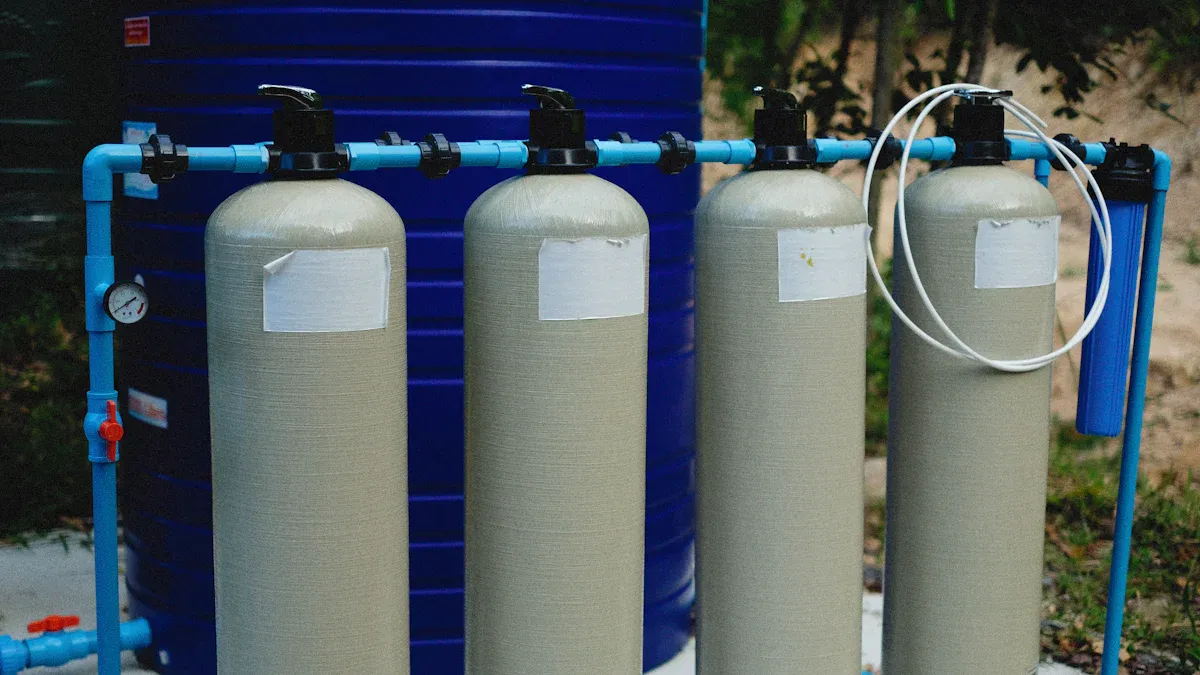
Effectiveness
Whole house filtration cleans water at every tap. You get clean water for showers and sinks. These systems use different filter media. They target many contaminants in the water. They remove chlorine, heavy metals, and bacteria. This helps keep your skin and hair healthy. Your health is safer every time you shower. Whole house filtration also makes water taste and smell better. It balances pH and removes odors. You can trust these systems to clean water well.
Cost Range (USD) |
|
|---|---|
1 |
$300–$1,000 |
2 |
$400–$1,200 |
3 |
$500–$1,200 |
4 |
$800–$1,200 |
5 |
$300–$2,300 |
Whole house filtration is very good at removing chlorine. It also removes other contaminants from all water in your home.
Installation and Maintenance
You need to plan for installation and upkeep. Most whole house filtration systems need a professional to set up. You may pay extra for permits and labor. You must replace filters and clean filter housings. Sediment pre-filters need changing every few months. Carbon filters last almost a year. Some tanks last for years. You should watch water pressure and check for leaks. Cleaning filter housings once a year stops bacteria from growing.
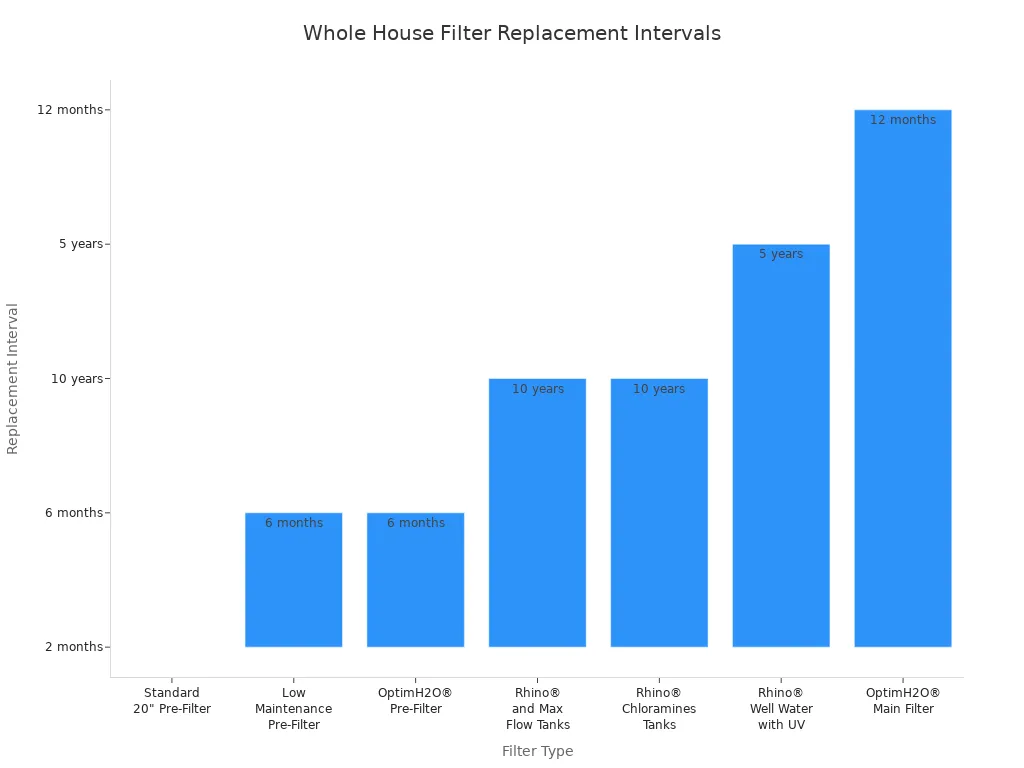
Pros and Cons
Whole house filtration has many benefits. These systems remove lots of contaminants. They take out chlorine, heavy metals, and bacteria. Your plumbing and appliances are safer. Your skin and hair feel better after showers. Water tastes and smells better. Whole house filtration can make your home worth more.
Advantages |
Disadvantages |
|---|---|
Removes a wide range of contaminants, including chlorine, heavy metals, bacteria, and VOCs |
High upfront cost, with systems ranging from $300 to $2,000 or more |
Protects plumbing and appliances |
Requires professional installation |
Improves skin and hair condition |
Needs additional space for installation |
Enhances water taste, smell, and texture |
May be impractical for renters |
Increases home value |
Requires periodic maintenance and filter replacement |
Whole house filtration gives you peace of mind. You know your water is clean every time you use it.
Water Softeners for Clean Water
Effectiveness
A water softener helps make shower water cleaner. It takes out hard minerals like calcium and magnesium. These minerals can dry your skin and make hair look dull. The softener swaps these minerals for sodium or potassium ions. This makes the water softer and better for your skin and hair. Hard water mixes with soap and leaves a sticky film. This film can block pores and make skin itch. Soft water lets shampoo and conditioner wash out well. Your hair feels softer and looks shiny. You keep your skin’s natural oils, so it does not get too dry. If you dye your hair, soft water helps the color last longer. A water softener does not take out chlorine. You can use a filter with it to remove chlorine and other chemicals. Many people see less hair breakage and healthier hair after using soft water.
Installation and Maintenance
A plumber can help you put in a water softener at home. You buy the system and connect it to your main water pipe. The cost depends on your plumbing and the size of the softener. Most people pay $300 to $1,000 to install one. If you need more plumbing work, it can cost more. After it is set up, you need to keep it working right. Salt-based softeners need salt or potassium added often. You should check the resin tank and change it if needed. Salt-free softeners use filter media that you change every few years. Salt-based systems cost more to keep up because you buy salt each month and clean the resin tank once a year. Salt-free systems are cheaper to maintain. Some companies can help you with service and upkeep.
Aspect |
Details |
|---|---|
Installation Cost |
$300–$1,000 (standard); extra plumbing may add $200–$800 |
Maintenance Tasks |
Salt/potassium refill, resin tank checks, filter media replacement |
Maintenance Cost |
Salt: $5–$10/month; resin cleaning: $100–$200/year; filter replacement: $20–$50 each |
Professional Service |
Optional annual servicing: $150–$300 |
Pros and Cons
A water softener gives you many good things for your shower water. It keeps your skin and hair safe from hard minerals. It also protects your pipes and appliances from scale. Soft water can give you better water pressure and cleaner dishes. You may have less dry skin and less itching if you use a softener and a filter. But there are some downsides. Salt-based softeners make wastewater and use power. Some places have rules about using them, so check your local laws first. Salt-free softeners do not use power or make wastewater, but they may not work as well if your water is very hard. Pick the best system for your needs and use a filter to remove chlorine and other bad stuff.
Tip: To lower both chlorine and hard minerals, use a water softener and a shower filter together.
Pipes and appliances last longer
Better water pressure
Dishes come out cleaner
Salt-based systems can hurt the environment
Some places have rules about softeners
You need to pay for upkeep and repairs
Inline and External Water Filter Shower Head Options
Effectiveness
You might wonder how well these filters work. Both use KDF-55, activated carbon, and sometimes vitamin C. These filter types help remove chlorine and heavy metals. They also take out some bacteria. Both filters remove about the same amount of chlorine. They do not get rid of hard minerals. If your water is hard, you need another solution. Multi-stage filters use more layers to catch more bad stuff. You may notice softer skin and healthier hair. This happens because less chlorine and heavy metals stay in the water.
Here is a table to help you compare:
Feature |
Inline Showerhead Filter |
Filter Shower Head |
|---|---|---|
Installation Location |
Between shower arm and showerhead |
Combined unit (showerhead + filter) |
Filtration Media |
KDF-55, activated carbon, vitamin C |
KDF-55, activated carbon, sometimes vitamin C |
Contaminant Removal |
Removes chlorine, heavy metals, some bacteria |
Removes chlorine, heavy metals, some bacteria |
Chlorine Removal Effectiveness |
Rated as 'Great' or 'Good' depending on brand |
Rated as 'Great' or 'Good' depending on brand |
Removal of Hard Minerals |
No |
No |
Certification |
Some NSF/ANSI certified |
Some NSF/ANSI certified |
Maintenance Interval |
Filter replacement every 3 to 12 months |
Filter replacement every 3 to 12 months |
Ease of Installation |
Requires fitting between shower arm and head; moderate skill |
Simple, no tools needed; easy installation |
Cost Range (Annual) |
Approximately $18-$45 depending on brand |
Approximately $18-$45 depending on brand |
These filters protect you from chlorine and heavy metals. They do not help with hard minerals.
Installation and Maintenance
You can put in these filters without special tools. Most twist on by hand. Inline filters let you keep your old shower head. Filter shower heads give your shower a new look. Replacement cartridges cost about $18 to $25. They last up to six months. Change the filter every 4 to 6 months. This depends on your water and how much you use it. Some filters remind you when to change them. Changing filters often keeps your water clean. It also helps your filter work well. You save money because you do not need a plumber.
Tip: Use real replacement cartridges. This helps your filter last longer and work better.
Pros and Cons
These filters have many good points. Your skin feels softer. Your hair looks healthier. The filter lowers chlorine and heavy metals. This helps stop dryness and irritation. You do not need to change your plumbing. Inline filters let you keep your favorite shower head.
Here is a quick look at the advantages and disadvantages:
Advantages |
Disadvantages |
|---|---|
Softer skin and healthier hair |
|
Reduces chlorine and heavy metals |
Regular filter replacement needed |
Easy installation |
May reduce water pressure slightly |
Keeps your current shower head (inline) |
Does not remove hard minerals or all bacteria |
Affordable replacement cartridges |
Not a full purification system |
These filters do not soften hard water. They do not remove every contaminant. For cleaner water everywhere, you may need a whole-house system. Still, these filters are an easy way to make your shower water better.
Portable and DIY Clean Water Solutions

Effectiveness
You have some portable and DIY ways to make shower water better. These choices help with different things in the water. Vitamin C can lower chlorine in your shower. Activated carbon filters also cut down chlorine and some chemicals. Portable purifiers with UV or KDF can take out some bacteria and chlorine. Most DIY ways do not get rid of heavy metals or all bacteria. Boiling water gets rid of chlorine, but you cannot use it for showers. Vinegar or lemon soaks only clean the showerhead, not the water.
Here is a table to compare these choices:
Solution Type |
Removes Chlorine |
Removes Heavy Metals |
Removes Bacteria |
Notes on Use and Limitations |
|---|---|---|---|---|
Vitamin C (DIY) |
Yes (some) |
No |
No |
Easy to use; best for chlorine; not for metals or bacteria. |
Activated Carbon (DIY) |
Yes (some) |
Some |
No |
Reduces chlorine and some chemicals; less effective with hot water. |
Portable Purifiers |
Some types |
Rarely |
UV and KDF types |
Good for travel; some remove chlorine and bacteria; may lower water pressure. |
Boiling Water (DIY) |
Yes |
No |
No |
Removes chlorine; not practical for showers. |
Vinegar/Lemon Soak |
No |
No |
No |
Cleans buildup on showerhead only. |
Most portable and DIY ways help with chlorine. They do not protect you from heavy metals or bacteria. For everyday use, a store-bought filter works better for clean water and healthy skin.
Installation and Maintenance
You can put in most portable and DIY filters without special tools. Vitamin C comes as tablets or powder. You add it to water before you shower. You can make activated carbon filters at home, but they may not fit every shower. Portable purifiers hook onto the shower arm or hose. You can move them if you change homes. These filters need to be replaced often. Most last a few months, depending on water and use. If water pressure drops or the smell changes, replace the filter. Boiling water is not good for showers because it takes too long and uses lots of energy. Vinegar or lemon soaks only clean the showerhead, not the water.
Tip: Always read the instructions for your filter. Change it on time to keep your water clean and safe.
Pros and Cons
Portable and DIY ways have many good points. You can install them easily. They work well for renters or people who move a lot. You spend less money at first. You can take portable filters to a new home. These filters help you clean the water you use most, like in your shower.
There are some downsides too. Portable and DIY filters may slow down water flow. You need to change filters often, which costs more over time. Most do not remove all bad things. They mostly help with chlorine and some chemicals. They do not clean all the water in your house or make your home worth more.
Aspect |
Pros |
Cons |
|---|---|---|
Installation |
Easy DIY, no plumber needed |
May not fit all showers |
Coverage |
Targets specific outlets like showers |
Does not treat all water in the home |
Initial Cost |
Low upfront cost |
Filter replacements add up |
Portability |
Easy to move |
Not as durable as whole-house systems |
Water Flow Impact |
Simple to use |
May reduce water pressure |
Maintenance |
Easy to replace filters |
Frequent replacements needed |
Best Use Case |
Renters, travelers, temporary setups |
Not for full home protection |
Home Value Impact |
No effect |
Does not increase property value |
You can use portable and DIY filters for cleaner shower water. They help lower chlorine and make you healthier, but they do not fix every water problem.
Comparing Filter Shower Head Alternatives
Effectiveness
You want to know which option makes water clean. The table shows how each choice removes chlorine, metals, and hard minerals. The Cobbe DS Filter Shower Head takes out almost all chlorine and many metals. Water softeners are best for hard minerals but do not remove chlorine or metals. Portable purifiers and DIY ways help with some chlorine but miss other bad things.
Solution |
Removes Chlorine |
Removes Heavy Metals |
Removes Hard Minerals |
Removes Bacteria |
Notes/Benefits |
|---|---|---|---|---|---|
Yes |
Yes |
No |
Some (KDF) |
Advanced filtration, high user ratings |
|
Whole House Filtration |
Yes |
Yes |
Some (with softener) |
Some |
Treats all water in your home |
Water Softener |
No |
No |
Yes |
No |
Best for softening water |
Portable Purifier |
Some |
Some |
No |
Some |
Good for travel, less for daily use |
DIY/Natural Methods |
Some |
Limited |
No |
No |
Limited effectiveness |
Tip: Use a water softener and a filter together for softer and cleaner water.
Cost
You should think about price and what you get. The Cobbe DS Filter Shower Head cleans water well and does not cost much. Other choices cost more at first or need pricey upkeep. The chart below shows how Cobbe’s price compares to others.
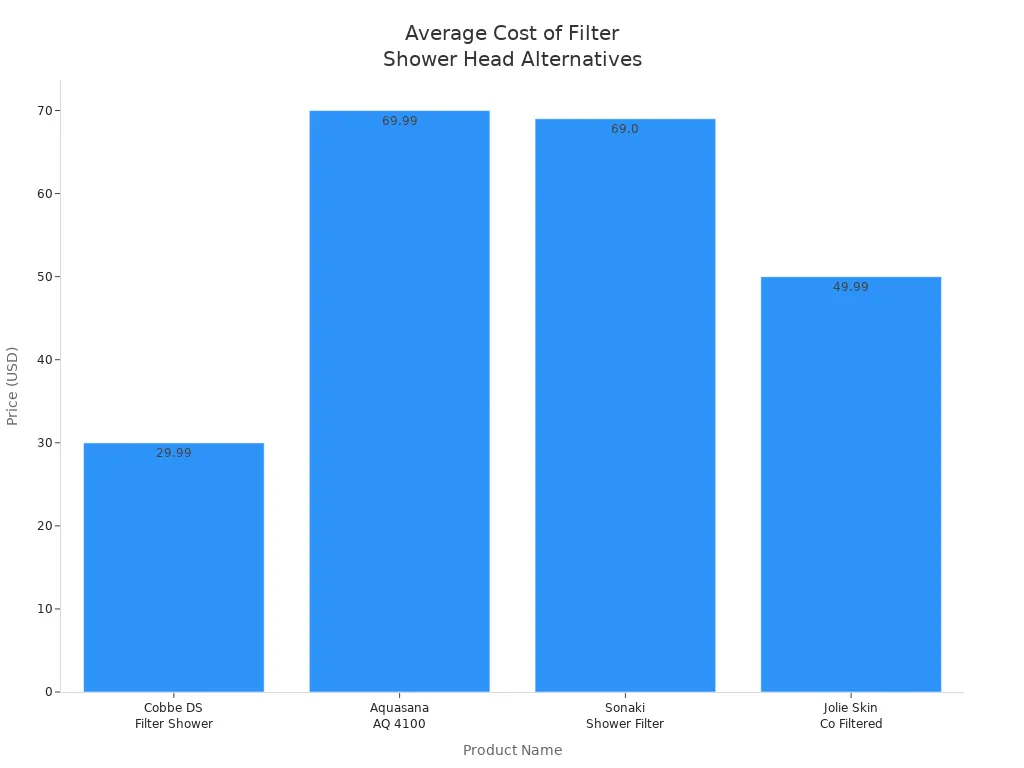
Product Name |
Price Range |
Filter Life / Replacement Cost |
Key Features |
|---|---|---|---|
Cobbe DS Filter Shower Head |
$29.99 |
$11.99 per filter; $20–$145/year |
20-stage filtration, 5 spray modes, high value |
Aquasana AQ 4100 |
$69.99 |
6 months, $50 per filter |
NSF certified, lifetime warranty |
Sonaki Shower Filter |
$69.00 |
1,300 gallons |
Strong chloramine removal |
Whole House Filtration |
$300–$2,000 |
$100–$300/year |
Treats all water, high initial cost |
Water Softener |
$400–$2,500 |
$60–$200/year |
Removes hard minerals, not contaminants |
Installation and Maintenance
You want something easy to put in and take care of. The Cobbe DS Filter Shower Head goes on fast and needs no tools. You change the filter every few months. Whole house systems and water softeners need a plumber and more work. Portable purifiers and DIY filters are simple to set up but need lots of changes and may not clean as well.
Filter Type |
Installation Requirements |
Maintenance Needs |
Ease for Homeowners |
|---|---|---|---|
Tool-free, fits most showers |
Replace filter every 3–6 months |
Very easy |
|
Whole House Filtration |
Professional installation needed |
Replace filters, regular checks |
Complex |
Water Softener |
Plumber needed, plumbing changes |
Salt refills, resin cleaning |
More effort |
Portable Purifier |
No tools, attaches easily |
Replace filter often |
Easy, but less durable |
DIY/Natural Methods |
Simple, homemade |
Frequent changes, less reliable |
Easy, but less effective |
Note: Most people find a filter shower head like Cobbe is easy to install, cleans water well, and does not cost a lot.
Choosing the Best Solution
Assessing Water Quality
First, you need to know what is in your water. Local water reports show if you have chlorine, heavy metals, or bacteria. You can use a home test kit for a fast check. Pick a filter that matches your water problems. KDF-55 filters help with heavy metals and chlorine. Activated carbon filters take out chlorine and bad smells. Ceramic filters catch dirt and bacteria. Calcium sulfite filters lower chlorine and chloramine. These are good for people with sensitive skin. Vitamin C filters are strong against chlorine and chloramine.
Factor / Filter Type |
Description / Benefit |
|---|---|
KDF-55 filters |
Lower heavy metals and chlorine, help skin and hair |
Activated carbon filters |
Remove chlorine and smells, make water fresher |
Ceramic filters |
Catch dirt, debris, and bacteria |
Calcium sulfite filters |
Lower chlorine and chloramine, gentle for sensitive skin |
Vitamin C filters |
Work well on chlorine and chloramine |
Think about how old your showerhead is. Old showerheads can hold bacteria and slime. As showerheads age, the risk of germs goes up. You can test for bacteria like E. coli, Legionella, and Pseudomonas. This helps you know if you need more protection.
Tip: Always test your water before you buy a filter. This helps you choose the best one for your needs.
Matching Needs and Budget
When you pick a water solution, think about your home and money. Renters need easy options like filtered shower heads or portable softeners. Homeowners might want whole house systems or electronic descalers. These protect pipes and add value to the house.
Option |
Upfront Cost |
Installation Ease |
Best For |
Maintenance Required |
|---|---|---|---|---|
Low |
Easy |
Renters |
Change filters sometimes |
|
DIY Cleaning |
Very Low |
None |
Anyone |
Clean often |
Portable Softener |
Medium |
Easy |
Renters/Travelers |
Recharge beads when needed |
Electronic Descaler |
Medium-High |
Moderate |
Homeowners |
Needs little care |
Magnetic Device |
Low |
Easy |
Anyone |
No upkeep |
Think about how often you want to do upkeep. Some filters need changing every few months. Others last longer but cost more at first. Certified filters, like NSF/ANSI Standard 177, make sure they work well. Always pick a filter that removes the things you worry about. If you have hard water, use a softener. If you worry about chlorine or metals, pick a filter with the right media.
Remember, the best choice depends on your water, your needs, and your budget. This helps you get good water and save money at home.
You can make your shower water clean in many ways. You do not need a filter shower head. Each way helps take out chlorine and other bad stuff. This keeps your skin and hair healthy. The table below shows the main things to look at:
Summary |
|
|---|---|
Water Quality |
Takes out chlorine and metals |
Filtration Media |
Multi-stage filters are the best |
Installation |
Most choices are simple to set up |
Maintenance |
Change filters every few months |
Think about what is in your water. Check your budget and what you need. Test your water before you pick a system. Follow the steps to keep it working well. With the right choice, you can have safe showers.
FAQ
Can you purify shower water without a filter shower head?
You have other ways to clean shower water. You can use whole house filters, water softeners, inline filters, portable purifiers, or DIY methods. Each choice helps with different bad things in the water. Test your water first so you know what you need.
How often should you replace shower water filters?
Most shower water filters need changing every 3 to 6 months. Always check the instructions from the maker. If water pressure drops or smells weird, change the filter sooner.
Do water softeners remove chlorine from shower water?
Water softeners only take out hard minerals like calcium and magnesium. They do not get rid of chlorine. You need another filter to lower chlorine in your shower water.
What is the easiest way to improve shower water for renters?
Renters can use a filtered shower head or a portable purifier. These choices do not need plumbing changes. You can take them out easily when you move.
Tip: Test your water before picking a filter. This helps you choose the best product for your needs.
